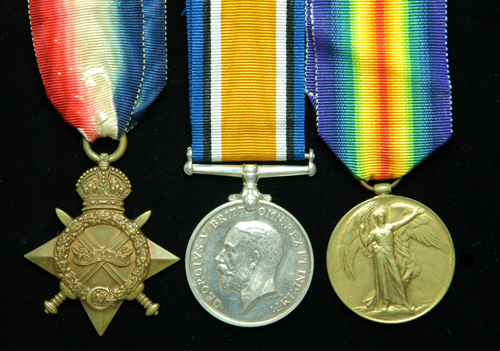
Auction: 7012 - Orders, Decorations, Medals & Militaria
Lot: 826
A First Day Battle of Loos Casualty Group of Three to Major W.R. Paterson, 10th Battalion, Gloucestershire Regiment, Whose Company Was Decimated in the Assualt 1914-15 Star (Capt. W.R. Paterson. Glouc.R.); British War and Victory Medals (Major W.R. Paterson.), good very fine, with photographic image of the recipient (3) Estimate £ 200-250 Major William Robert Paterson, born Wendover, Cheltenham, 1885; educated at Cheltenham College and Queen´s College Manchester; commissioned Second Lieutenant Gloucestershire Regiment, September 1914; advanced Major 10th Battalion Gloucestershire Regiment, 11.9.1915 and Commanded No. 4 Company on the 1st day of Operations of the Battle of Loos, 25.9.1915. ´ At 6.30 a.m. the battalion assaulted the primary objective, the first line system of the German defence, which included three line of entrenchments. The assault was carried out in three lines, frontage being Bois Carree inclusive to Point 39 in G 17d. The attack was delivered..... with the accompaniment of gas and smoke. The wind was not quite favourable with the result that from the start several men were affected. Notwithstanding this drawback the three lines moved forward punctually to the moment, machine guns accompanying. The German´s wire entanglement which had been torn into gaps by bombardment proved a considerable obstacle. The wind proved more favourable to the enemy than ourselves, in the smoke, direction was not properly maintained, but deflected to the right. Heavy resistance was encountered at the support and reserve German works. At the first, the enemy eventually evacuating these positions and retreating towards Hulluch. Our bombers suffered severely, their bombs in the main refusing to explode; the Brock lighter having got wet with rain; which fell in the early morning. Nevertheless the assault was pushed home with the utmost resolution over the second German line into the third, and up the flanking communication trenches to eastwards. In this phase the Camerons and Black Watch co-operated. The officers fell as the position of their bodies showed, leading their men, and 16 out of 21 officers were lost. The bodies of our dead indicated how they died with faces to the enemy. One of our machine guns was put out of action coming over the parapet, but two other guns reached a point in advance of Point 89 (Lt. Royds and 2/Lt. Turner and Lismore with 3 machine guns and 40 men garrisoned keep 89, strengthening positions there and at point 76 G18a) constructed later. The action resulted in many German surrenders, and their flights from the position they were forced to evacuate by the continuous push of the assault. During night, under heavy rain, the unit was reformed with 60 survivors assembling, increased by the third day to 130.´ (10th Battalion´s War Diary refers); the same source also gives Paterson as wounded during the attack, at Hulluch; he was sent to recover from his wounds at Dublin Hospital, however he never fully recovered and was invalided out of the Army, 9.6.1916, and issued with a Silver War Badge (No. 149138).
Sold for
£300




